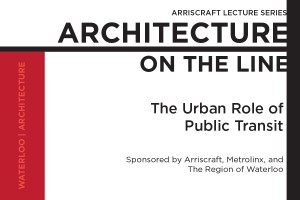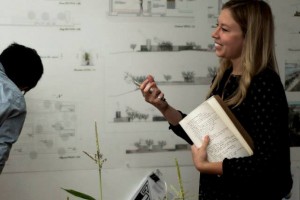
Modern architecture is the vernacular of Waterloo.
– Rick Haldenby, Executive Curator
Early European works of architecture are studied worldwide with religious zeal. They formed the foundation for thousands of years of design work, from the ancient temples of Greece and Rome to medieval fortresses in the United Kingdom. These works carried weight throughout the centuries, and their impact still resonates with contemporary buildings around the globe. Despite the fact that these works carry a huge architectural and cultural weight, they’re not involved with contemporary industry. Other places, most notably in the United States, are renowned and studied for their technological innovation. The names Google, DARPA, and MIT are known to people everywhere for their contributions to society as a whole, yet they aren’t intrinsically tied to architecture.

Building Waterloo Region (buildingwaterlooregion.ca) is a series of exhibitions that explores the unique blend of industry, architecture, and design in the Kitchener/Waterloo area. For decades, Waterloo’s cultural identity has been caught in a state of flux between heritage preservation and progressive modernism, an issue that covers our cultural roots, contemporary industry, and architectural design. Part of the Building Waterloo Region project is to argue that modern is the vernacular of Waterloo Region, and that these sites are as much a part of our heritage as historically recognized pieces of architecture. In a lot of cases, newer buildings are the same age as heritage properties when they were protected. Many of these buildings have won awards, with the Waterloo Region holding more Governor General’s Awards for Architecture than any other municipality in Canada. This is the focus of the No Small Plans exhibition, which highlights eight internationally-renowned buildings. No Small Plans opens July 5 at the Canadian Clay and Glass Gallery in Uptown Waterloo and runs until August 31.
In Waterloo Region, there is a trend of industrial re-use, turning old, outdated factories and storehouses into incubators for contemporary practices–an example is the old Seagram Museum, which now houses a portion of the Centre for International Governance Innovation. This trend can be seen beginning around the end of the Second World War and continuing on into the late twentieth century as physical industry was replaced by digital start-ups, many of which went on to achieve worldwide recognition. These topics are explored within the Ex-Industria venue. Ex Industria opens on July 4 at Design at Riverside within Waterloo Architecture at 7 Melville Street South in Cambridge and runs until September 21.
The digital makeover of Waterloo, given its young age, might suggest that heavy industry and progressive ideologies encompasses the whole history of the Region. First Builders is an exhibition that explores the foundations of our culture, looking back over 10,000 years of change to the earliest settlements right up to the first appearance of European settlers. This exhibit takes visitors on a tour through ancient woods, exploring the changing ecosystem and successive cultures that existed within the physical boundaries of the rare site, a 900+ acre research reserve (www.raresites.org). In addition to wooded meanderings, the event showcases locally produced sustainable architecture and exhibits on the cultural history of Blair. First Builders opens on July 5 and runs until September 1.

Building Waterloo Region is the largest multi-institutional program of architectural events and exhibitions in Canada, tying together industry, fashion, culture, and architecture. The official website can be found here, along with descriptions, information, and dates pertaining to each of the venues.
I'm currently working as a designer/fabricator at Boko, a multi-disciplinary studio based in New Hamburg, Ontario, doing whatever work comes through the door. I've also recently completed my first video game release, called Polyball, on the Steam distribution platform.
INSTAGRAM // @aaroncote



